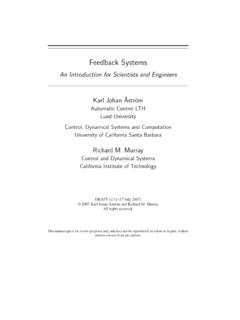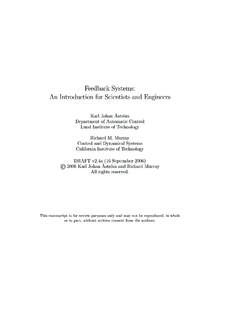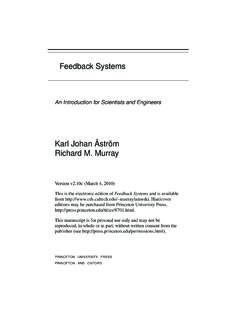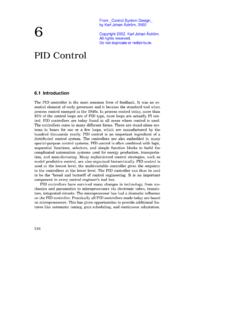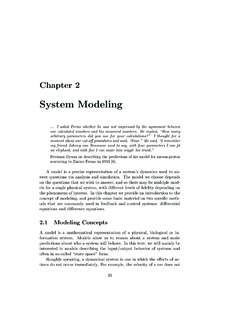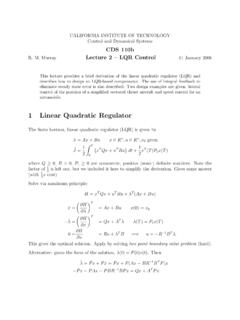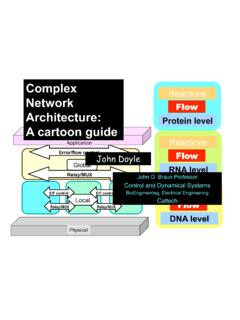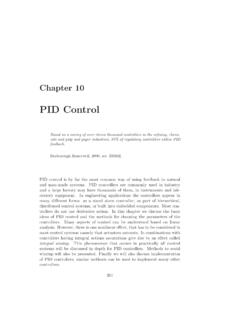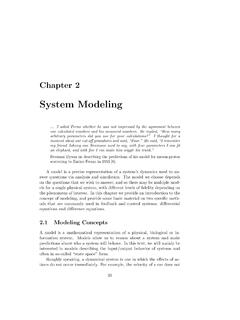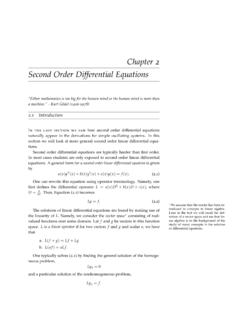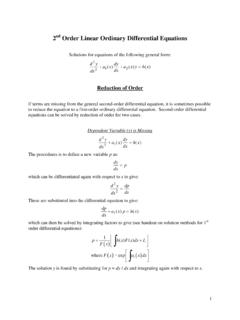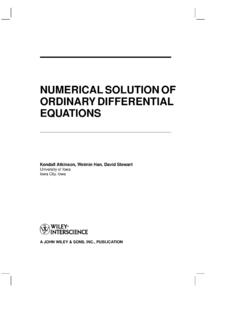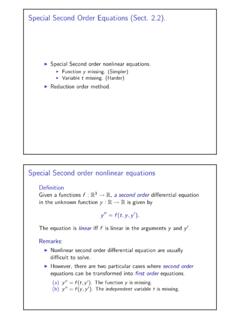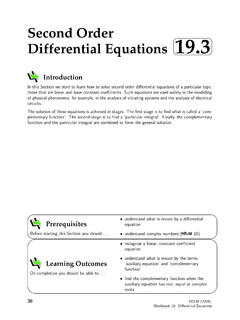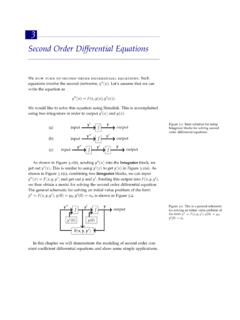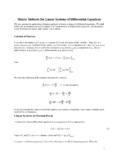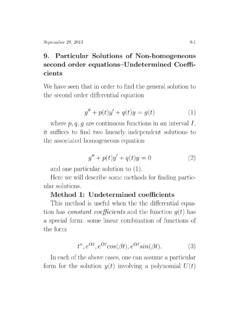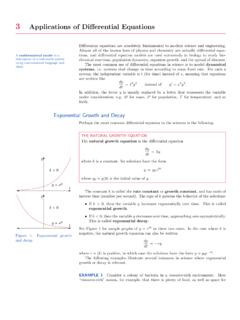Transcription of Simple Control Systems - Graduate Degree in Control
1 4 Simple Control IntroductionIn this chapter we will give Simple examples of analysis and design ofcontrol Systems . We will start in Sections and with two systemsthat can be handled using only knowledge of differential equations . Sec-tion deals with design of a cruise controller for a car. In Section discuss the dynamics of a bicycle, many of its nice properties are dueto a purely mechanical feedback which has emerged as a result of trialand error over a long period of time. Section is a suitable prepara-tion for Sections and differential equations are cumbersome formore complicated problems and better tools are needed. Efficient meth-ods for working with linear Systems can be developed based on a basicknowledge of Laplace transforms and transfer functions.
2 Coupled withblock diagrams this gives a very efficient way to deal with linear block diagram gives the overview and the behavior of the individualblocks are described by transfer functions. The Laplace transforms makeit easy to manipulate the system formally and to derive relations betweendifferent signals. This is one of the standard methods for working withcontrol Systems . It is exploited in Section , which gives a systematicway of designing PI controllers for first order Systems . This section alsocontains material required to develop an intuitive picture of the proper-ties of second order Systems . Section deals with design of PI and PIDcontrollers for second order Systems . A proper background for Sections is Section Section deals with the design problem for sys-tems of arbitrary order .
3 This section which requires more mathematicalmaturity can be omitted in a first reading. For the interested reader itgives, however, important insight into the design problem and the struc-ture of stabilizing controllers. Section summarizes the chapter Cruise ControlFigure diagram of a car on a sloping some important issues that should be Cruise ControlThe purpose of cruise Control is to keep the velocity of a car driver drives the car at the desired speed, the cruise Control systemis activated by pushing a button and the system then keeps the speedconstant. The major disturbance comes from changes of the slope of theroad which generates forces on the car due to gravity. There are alsodisturbances due to air and rolling resistance.
4 The cruise Control systemmeasures the difference between the desired and the actual velocity andgenerates a feedback signal which attempts to keep the error small inspite of changes in the slope of the road. The feedback signal is sent toan actuator which influences the throttle and thus the force generated bythe will start by developing a mathematical model of the system. Themathematical model should tell how the velocity of the car is influencedby the throttle and the slope of the road. A schematic picture is shown inFigure will model the system by a momentum balance. The major part of themomentum is the product of the velocityvand the massmof the car. Thereare also momenta stored in the engine, in terms of the rotation of the crankshaft and the velocities of the cylinders, but these are much smaller denote the slope of the road, the momentum balance can be145 Chapter 4.
5 Simple Control SystemsSlope of roadVelocityDesired velocityThrottleFEngineControllerBody Figure diagram of a car with cruise asmdvdt cv F mn the termcvdescribes the momentum loss due to air resistance androlling andFis the force generated by the engine. The retarding forcedue to the slope of the road should similarly be proportional to the sineof the angle but we have approximated sin . The consequence of theapproximations will be discussed later. It is also assumed that the forceFdeveloped by the engine is proportional to the signalusent to the parameters for a particular car, an Audi in fourth gear, themodel becomesdvdt u 10 the Control signal is normalized to be in the interval 0 u 1,whereu 1 corresponds to full throttle.
6 The model implies that with fullthrottle in fourth gear the car cannot climb a road that is steeper than10%, and that the maximum speed in 4th gear on a horizontal road isv 1 50 m/sD180 it is desirable that the controller should be able to maintainconstant speed during stationary conditions it is natural to choose a con-troller with integral action. A PI controller is a reasonable choice. Such acontroller can be described byu kDvr vE kiZt0 Dvr vD EEd block diagram of the system is shown in Figure To understand howthe cruise Control system works we will derive the equations for the closedloop Systems described by the effect of theslope on the velocity is of primary interest we will derive an equation thattells how the velocity errore vr vdepends on the slope of the Cruise ControlAssuming thatvris constant we find thatdvdt dedt,d2vdt2 d2edt2It is convenient to avoid dealing both with integralsand derivatives.
7 Differentiating the process termdu/dtcan be eliminated and we find the following equation that describes theclosed loop systemd2edt2 kEdedt kie 10d can first observe that if andeare constant the error is zero. Thisis no surprise since the controller has integral action, see the discussionabout the integral action Section understand the effects of the controller parameterskandkiwecan make an analogy the differential equation for amass-spring-damper systemMd2xdt2 Ddxdt Kx 0We can thus conclude that parameterkinfluences damping and thatkiinfluences closed loop of second order and it has the charac-teristic polynomials2 kEs can immediately conclude that the roots of this polynomial can begiven arbitrary values by choosing the controller parameters properly.
8 Tofind reasonable values we compare the characteristic polynomial with thecharacteristic polynomial of the normalized second order polynomials2 2 0s denotes relative damping and 0is the undamped natural fre-quency. The parameter 0gives response speed, and determines theshape of the response. Comparing the coefficients of the closed loop charac-teristic the standard second order find that the controller parameters are given byk 2 0 4. Simple Control signalFigure of a car with cruise Control for a step change in the slope ofthe road. The controllers are designed with relative damping 1and 0 , 0 0 it is desirable that a cruise Control system should respond to changesin the slope in a smooth manner without oscillations it is natural to choose 1, which corresponds to critical damping.
9 Then there is only one pa-rameter 0that has to be determined. The selection of this parameter isa compromise between response speed and Control actions. This is illus-trated in Figure which shows the velocity error and the Control signalfor a simulation where the slope of the road suddenly changes by 4%. No-tice that the largest velocity error decreases with increasing 0, but alsothat the Control signal increases more rapidly. In the Simple assumed that the force responded instantaneously to the throttle. Forrapid changes there may be additional dynamics that has to be accountedfor. There are also physical limitations to the rate of change of the limitations, which are not accounted for in the Simple ,limit the admissible value of 0. Figure shows the velocity error andthe Control signal for a few values of 0.
10 A reasonable choice of 0isin the range of to The performance of the cruise Control systemcan be evaluated by comparing the behaviors of cars with and withoutcruise Control . This is done in Figure which shows the velocity errorwhen the slope of the road is suddenly increased by 4%. Notice the Bicycle Dynamics010203040506070809010005101520 TimeVelocity errorFigure of a car withDsolid lineEand without cruise controlDdashedlineEfor a step change of 4% in the slope of the road. The controller is designed for 0 between the open and closed loop the chosen parameters 0 1wehave2 0 it follows the parameterc has little influenceon the behavior of the closed loop system since it is an order of mag-nitude smaller than 2 0.
